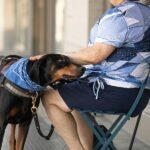Dogs happen to be the favorite pets in America, with millions of households showering their love on them. To be exact, a survey published by Statista reports that an estimated 68 million households in the country owned at least one canine companion in 2024. That’s a huge lead over the number of families owning cats, which stood at 49 million.
However, raising a dog is not a piece of cake as you need to do a lot to fulfill your pet-parenting responsibilities. Feeding, training, and vet visits are the obvious tasks. Reading and decoding canine body language is less obvious but it matters as much as anything else. It can help you build a strong, trusting relationship with your dog and ensure their well-being.
Dogs communicate primarily through body language. Understanding these cues can help you respond appropriately to their needs, emotions, and potential issues. In this article, we will share a few tips you can rely on to decode your Fido’s body language effectively.
Know Your Dog’s Personality
Every dog has a distinctive personality shaped by genetics, early experiences, training, and socialization. The breed also plays a dominant role in this context. The American Kennel Club cites a study showing that behavioral tendencies run within lineages of dogs. This is because specific genes lead to certain characteristics, just like in humans.
Some dogs are naturally confident and outgoing, while others may be more insecure or shy. Recognizing your dog’s baseline behavior and temperament can help you interpret their body language accurately.
For example, a confident dog will hold its head high, have ears upright, and carry its tail at mid to high position. Conversely, an insecure dog may lower its head, pin its ears back, tuck its tail, or display a bowed-back posture.
Look for Subtle Cues
Dogs communicate through subtle signals. Even seasoned pet parents may miss these signs if they’re not paying close attention. Watch out for the common subtle cues and learn to read them to know what your canine buddy wants to say.
Lip licking, yawning, or turning away can indicate stress or nervousness. Lowered body posture or curving the spine means they want to avoid conflict. Sideways glances or showing the whites of the eyes signal fear or discomfort.
On the positive side, relaxed ears and a slightly open mouth are indicative of a calm and happy dog. Play bows and quick, rigid postures show playfulness and curiosity. Learning to recognize these subtle behaviors helps you understand what your dog is feeling before it escalates into more obvious signs.
Be Extra Watchful About Aggression
Aggression in dogs can be complex and dangerous. Besides being hazardous to dog parents and their families, they can spell legal trouble. In 2024, a Chicago man was found dead in his apartment with multiple dog bites on his body. Several dogs lived in the complex, leading to suspicion. The victim’s family will seek justice with the help of the best personal injury lawyer in Chicago.
TorHoerman Law notes that dog bite cases come under the purview of personal injury laws. Victims are entitled to compensation if they prove the dog owner’s negligence. As a pet parent, you must identify early warning signs to prevent bites or fights. Aggressive behaviors may stem from reasons like dominance, fear, or territorial disputes.
Signs to watch for include growling, snarling, or baring teeth with curled lips. Look for subtle hints like a stiff, tense posture and raised hackles (fur along the back). You may also see their tail held high and rigid or direct, fixed eye contact or lunging. If your dog exhibits aggression regularly, a veterinarian or dog trainer can help.
Pay Attention to External Factors
Your dog’s environment and experiences can also influence their behavior and body language. According to NIH, early experiences are particularly important. Canine behavioral development depends on the environment and social rearing they get as puppies initially.
Even training and prenatal stress can influence how your dog responds to stimuli. Don’t overlook these factors when learning to read the canine body language. Stressful situations like loud noises, unfamiliar people, or other animals can trigger anxiety or aggression.
Always consider the context when interpreting body language. For example, a dog may appear tense and alert in a new environment but relaxed at home. This will help you remove the animal from a stressful situation based on their body language.
FAQs
What is a red flag in a dog’s behavior?
Red flag behaviors in dogs include constant aggression. This includes growling, snapping, lunging, excessive barking, destructive chewing, pacing, and urination or defecation indoors. Most dogs exhibit these behaviors due to stress. These behaviors can indicate serious underlying issues and should be addressed sooner rather than later.
What is an insecure dog’s body language?
An insecure dog will display body language such as a lowered head, tucked tail, pinned back ears, and bowed or curved back. They may avoid eye contact, approach strangers hesitantly, or lie close to walls or furniture instead of open spaces. Tail wagging can indicate anxiety or submission rather than happiness.
What is a relaxed dog’s body language?
A relaxed dog shows a loose, comfortable posture. You will see that its ears are either forward or gently back, a slightly open mouth, and soft eyes that may squint slightly. Their tail is held in a neutral or wagging position. They may expose their belly or stretch out comfortably. Playful behaviors like bows and gentle jumps are also signs of happiness.
Decoding your dog’s body language is a skill that deepens your bond with it. Eventually, it helps you meet the emotional and physical needs of your furry buddy. Reading cues may be challenging initially, but a little attention can take you a long way.











